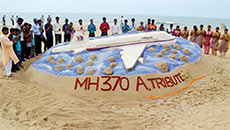Indian Mujahideen's operational head Tehsin Akhtar, now in police custody, embraced terrorism when he was only 18 years old.
Such was his passion that his handlers immediately inducted him into the banned outfit.
Lessons in 'jehad' quickly followed for the resident of Samastipur in Bihar.
In the initial stages of his involvement with the Indian Mujahideen, Tehsin -- as he is better known -- met Gayur Ahmad Jamali, who was to be arrested in 2011, also by Delhi Police.
The year was 2010 when the group's then Indian operational head, Yasin Bhatkal was setting up a module in Darbhanga in Bihar.
It was Jamali who introduced Tehsin to another Indian Mujahideen operative, Kafeel Akhtar, as well as Yasin Bhatkal.
Yasin Bhatkal is now in jail along with his associate Asadullah Akhtar alias Haddi.
“Yasin taught Tehsin all about 'jehad' and inducted him into IM," Special Commissioner of Police S.N. Srivastava told IANS.
It was Yasin Bhatkal who gave Tehsin his first code name: Hassan.
Then began Tehsin's armed training started -- in Waziristan in Pakistan.
His first lesson was how to use and assemble explosives known as petrol bombs, said Srivastava, who heads the Special Cell in Delhi Police charged with tracking and arresting terrorists.
Tehsin's first assignment was to act as the carrier for Adil Ajmal, a Pakistani national, to ensure that he safely crossed over to Nepal from Pakistan.
In Kathmandu, Tehsin also received Zia-ur-Rehman alias Waqas, another Pakistani who was arrested by Delhi Police Friday from Rajsthan, and Asadullah Akhtar at the airport.
Tehsin provided logistic support to Waqas and Haddi and sent them to carry out the Sep 19, 2010 bomb explosion outside Jama Masjid in Delhi's old quarters.
Later, he along with Yasin, Waqas and Haddi executed the 2010 bombing at Varanasi's Sheetla Ghat during the evening 'aarti'.

In the beginning of July 2011, Yasin Bhatkal directed Tehsin to come to Mumbai.
On July 13, 2011, Tehsin along with Yasin Bhatkal and others executed serial bombings in Mumbai's Zaveri Bazaar, Opera House and Dadar West.
Tehsin had placed an improvised explosive device at the Dadar railway station's foot-over bridge, said Srivastava.
After the Mumbai attack, Tehsin executed the February 2013 serial bombings at Dilsukhnagar in Hyderabad -- along with Waqas and Haddi.
He then took shelter in Jaipur and Jodhpur where he set up the Rajasthan module of the Indian Mujahideen.
That group was made up of Maroof, Waqar and Shaquib, all of whom were arrested Saturday by Delhi Police.
When Yasin and Asadullah were arrested by the National Investigation Agency (NIA) in 2013, a panicky Tehsin left Jodhpur and reached Kathmandu.
Thereafter, he came in touch with Waqas at the end of December 2013 and stayed with him till mid-January 2014 at Munnar in Kerala.
He had been directed Waqas to reach Ajmer and coordinate with the Rajasthan module in their preparation to commit the next terror strike.
Among their targets was the wildlife sanctuary at Bharatpur in Rajasthan.
This was apparently to avenge the Gopalgarh mosque firing of 2009 in which 10 people belonging to the Meo Muslim community were killed, said another investigating official.
Apart from being the present acting chief of IM, Tehsin became the single most important link between his group and some independent splinter groups which have emerged from the original Students Islamic Movement of India (SIMI) stable.
After the arrest of Yasin Bhatkal, Tehsin was the right hand man not just of Riyaz and Iqbaal Bhatkal but also for several other members of the Indian Mujahideen now based in Pakistan.





